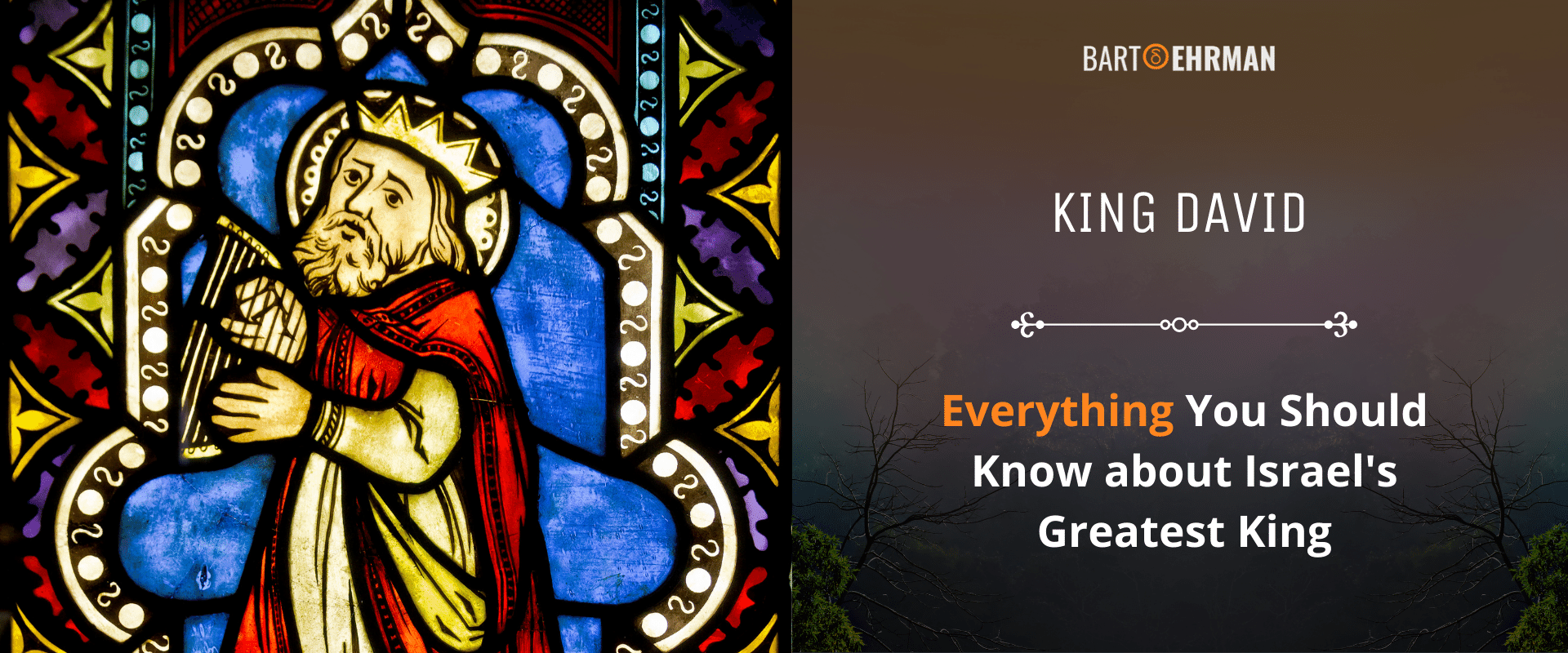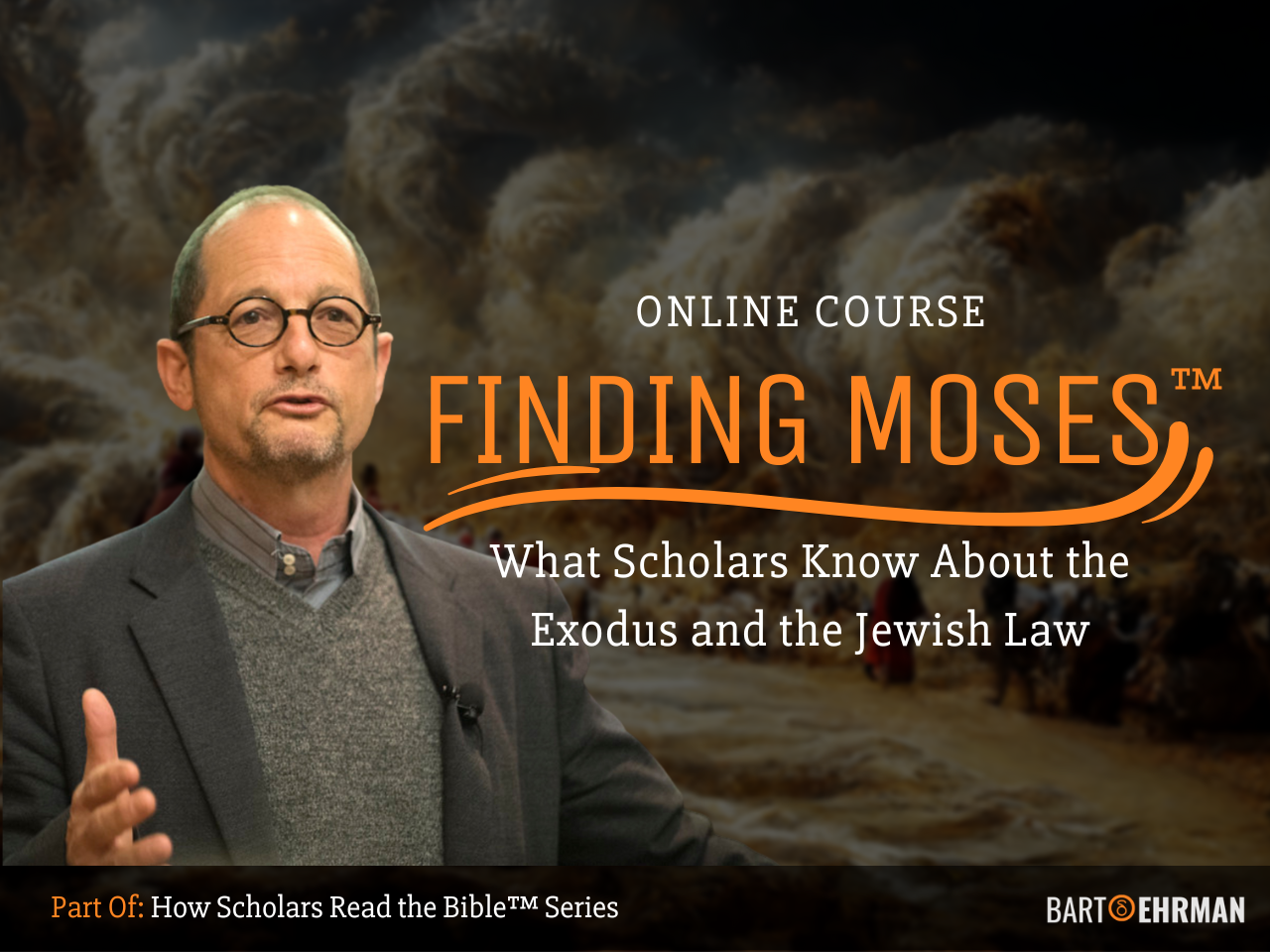King David: Everything You Should Know about Israel's Greatest King

Written by Marko Marina, Ph.D.
Author | Historian | BE Contributor
Verified! See our guidelines
Verified! See our editorial guidelines
Date written: May 11th, 2024
Disclaimer: The views and opinions expressed in this article belong to the author and do not necessarily match my own. - Dr. Bart D. Ehrman
During my last visit to Florence, I stood before Michelangelo's captivating sculpture of David in the Galleria dell'Accademia. That encounter prompted me to think more deeply about David's historical figure and his significance in Judaism and Christianity.
The powerful form of the marble youth, poised in a moment of contemplative determination, serves as a perfect introduction to a figure who is as complex as he is heroic. This legendary king, warrior, musician, and poet has left a profound imprint not only in religious texts but also in the very fabric of cultural history.
King David remains a pivotal figure in the Bible, revered as a model of righteous leadership and deep faith. His story, from his humble beginnings as a shepherd boy to his ascension to the throne of Israel, is more than just a historical account - it's a narrative rich with themes of power, redemption, guilt, and prophecy.
In this article, we aim to explore King David not just as he is depicted in the Bible but also through the lens of contemporary scholarship. Our journey through the life and legacy of David in the Bible will, therefore, be complemented by insights from modern archaeologists and historians. Their research challenges and enriches our understanding of the biblical narratives, offering a more nuanced picture of the ancient world.
But before we delve deeper into the life of King David, consider enhancing your understanding of Biblical narratives with Bart D. Ehrman's online course, "Finding Moses: What Scholars Know About the Exodus and Jewish Law."
This scholarly and historical exploration differentiates between history and myth in profound Biblical stories, including the Parting of the Red Sea. Join the course to deepen your insights into these timeless tales.
To ensure a clear presentation of the most important facts about David's life as described in the Bible, we have decided to create the following table. With this information in mind, we can begin to explore his life and legacy.
Aspect | Details |
|---|---|
Reign | C. 1010 - 970 B.C.E. |
Predecessor | Saul |
Successor | Solomon |
Number of Wives | At least 8, possibly more |
Capital of his Kingdom | Jerusalem |

Who is David in the Bible? (The Story of King David)
To situate the story of David within the Biblical narrative, we have to start with the tumultuous period following the Israelites’ settlement in Canaan. As depicted in 1 Samuel, this conflict set the stage for the emergence of Israel’s first formal leader, Saul who was from the tribe of Benjamin. According to the Bible, he ruled in the late 11th century B.C.E.
Saul was appointed as the nagid, a term denoting a supreme military leader, around whom the tribes united. Under his command, the Israelites managed to fend off not only the Ammonites but also the Philistines, securing crucial respite for the burgeoning nation.
However, Saul’s leadership encountered significant challenges. Although initially successful, he failed to capitalize fully on his victories, particularly against the Philistines. Instead of driving them back to their territory in Philistia, Saul’s efforts resulted in a prolonged stalemate.
This ongoing war of attrition saw territories repeatedly changing hands, with neither side able to secure a definitive advantage. It was during these uncertain times that a pivotal new figure would rise, destined to leave an indelible mark on Israelite history and identity.
Enter David, a shepherd boy from Bethlehem, who would become central to the story of Israel’s emergence as an independent kingdom. What does David mean? His name in Hebrew means “beloved” or “darling” and carries on the symbol of leadership and importance that transcends beyond his lifetime.
Known for his wisdom and intelligence far beyond his years, David gained entry to Saul’s court through his exceptional musical talents, playing the harp and composing songs that greatly pleased the troubled king. Recognizing his potential, Saul appointed David as his armor bearer.
The rest of 1 Samuel (15: 35 - 31:13) recounts the parallel process in which Saul’s power and influence decline as David rises. As Mark W. Hamilton observes: “In part, the narrative attempts to vindicate David of possible charges of treason and banditry by explaining how in each case when he benefits from the death or defeat of someone else, circumstances extenuate his actions.”
This introduction of David sets the stage for one of the most famous episodes in the biblical narrative - the story of David and Goliath. As we continue, we’ll delve into this legendary encounter thus illustrating how King David's humble beginnings foreshadowed his future as a pivotal leader of Israel.
David and Goliath Story: The Great Victory and the Emergence of the Davidic Kingdom
As the Israelites faced another grave threat from the Philistines, they encountered a new and formidable challenge—a giant named Goliath who could be described as a "weapon of mass destruction”. The mere sight of this towering enemy filled the Israelite soldiers with dread.
However, amidst the fearful ranks, a young David remained undaunted. Armed with nothing but a sling and a stone, David confronted the giant, striking Goliath squarely on the forehead. The impact felled the giant, and David quickly finished him off with his sword. The Philistine army, seeing their champion defeated, fled in disarray, turning the tide of battle in favor of the Israelites.
Bill T. Arnold explains the essence of the David and Goliath story by noting that this is “about more than a dramatic victory over a terrifying enemy. Saul, who was anointed to provide deliverance from the Philistines, is paralyzed by the crisis, whereas David is fearless. This military victory validates David’s anointing as the king of Israel and shows that Saul is king in name only.”
The victory over Goliath catapulted David into the limelight, with the people clamoring for him to lead their army—a request King Saul felt compelled to honor, despite his growing envy and suspicion of David's rising popularity.
Yet, Saul's jealousy soon turned lethal, forcing David to flee for his life, finding refuge near the Dead Sea. The political landscape continued to shift rapidly after Saul and several of his sons fell in subsequent battles against the Philistines, leading to Saul's tragic suicide on the battlefield.
Amidst the ensuing power vacuum, internal divisions emerged among the Israelites. While the northern tribes supported Saul's remaining son, Ishbaal, the southern tribes rallied behind David. This discord was resolved when David cleverly negotiated the return of his wife, Michal, Saul's daughter.
This reunion not only secured his political base but also linked him once more to the royal lineage of Saul, thereby solidifying his claim to the throne and beginning his reign as King David.
The Kingdom of David
The Kingdom of David, established according to the Biblical tradition in the early 10th century B.C.E., marked a significant turning point in the history of Israel. Upon ascending to the throne, David’s initial actions weren’t directed towards immediate military campaigns against the Philistines but towards solidifying the fragile alliance of the tribal federation.
Understanding the critical need for a united nation capable of sustaining and defending itself, David focused on creating strong national structures. This included recruiting and training a national army, organizing the economy, levying taxes, and rallying the populace around a common identity that transcended tribal divisions.
To achieve these goals, David chose Jerusalem as the capital - a strategically wise and symbolically neutral choice. Perched on a high ridge and flanked by three valleys, Jerusalem offered natural defense advantages and stood on the border between Judea and the northern tribes.
The capture of Jerusalem was accomplished ingeniously and with minimal bloodshed! David used a covert operation that involved soldiers entering the city through a water shaft. This not only prevented a massacre - crucial for future cohabitation - but also demonstrated King David’s tactical shrewdness.
The consolidation of Jerusalem alarmed the Philistines, prompting them to mount an offensive. However, under David’s leadership, the newly organized Hebrew army repelled the Philistine forces not once, but twice, decisively driving them back to the coastal plains of Philistia.
These victories not only secured David’s military reputation but also ensured the stability of his kingdom.
In the later years of his reign, as recounted in the story of David in the Bible, his rule was marked by both prosperity and internal strife, including familial discord and rebellion. Despite these challenges, David's reign is remembered as a golden era of leadership and cultural development.
King David’s death, as described in the Biblical narrative, came after a forty-year reign, leaving a legacy that would deeply influence both the historical and spiritual trajectory of the Israelite people.
How Many Wives Did King David Have?
Name | Order | Significance |
|---|---|---|
Michal | 1st | Daughter of King Saul; marriage linked David to the royal family; was initially estranged from David and later returned to him. |
Ahinoam | 2nd | Jezreelite from the northern tribes; highlights David's efforts to forge alliances across different regions. |
Abigail | 3rd | Widow of Nabal from the southern tribes; solidified David's support in the south. |
Maakah | 4th | Princess from the neighboring kingdom of Geshur; likely a diplomatic marriage for political alliance. |
Haggit | 5th | Details about her are not well known from the Bible. |
Abital | 6th | Little is known about her background or role. |
Eglah | 7th | Not much is known, but she was part of David's harem in Jerusalem. |
Bathsheba | 8th | Known for her affair with David, which led to the death of her husband Uriah; mother of Solomon, David's successor. |
King David's marital alliances weren’t just personal choices but strategic moves that played a significant role in his political and social reign. Initially, David married Michal, the daughter of King Saul, which symbolized his entry into the royal family and legitimized his claim to the throne. However, his marital connections extended beyond this union.
David's wives included Ahinoam the Jezreelite from the north, and Abigail the widow of Nabal from the south, further illustrating his efforts to forge alliances across different tribes and regions within his kingdom.
Additionally, he married Maakah, a princess from the neighboring kingdom of Geshur, which likely served as a diplomatic bond between the nations.
David’s marriages to other women such as Haggit, Abital, and Eglah, whose origins are less clearly defined in the Bible, as well as his subsequent marriages to several other women after the establishment of his reign in Jerusalem, underline the complexity and politically charged nature of his marriages.
One of the most renowned stories that highlights the interplay of power and personal relationships within David's life is his affair with Bathsheba. This relationship not only led to significant personal and public turmoil but also had dire political consequences.
After spotting Bathsheba bathing, David, captivated by her, summoned her to his palace, leading to an affair that resulted in pregnancy. In an attempt to conceal this, David orchestrated the death of Bathsheba's husband, Uriah, a loyal soldier, by placing him on the front lines of battle.
This act drew harsh criticism from the prophet Nathan and marked a turning point in David's reign, bringing turmoil and division within his family.
Mark W. Hamilton summarizes the importance of David’s personal life: “The politics of the harem and its children plays a major role in the stories about David, from his off-again, on-again marriage to Michal to the rivalry between Absalom and Amnon. In several cases, the women exert significant influence on David and others, sometimes changing the course of affairs by their actions.”
So, how many wives did David have? According to the Bible, King David had at least eight wives mentioned by name. Additionally, the Bible notes that he had other wives and concubines - particularly after he became the king with the capital in Jerusalem.
While David's many marriages illustrate the complexity of his personal and political life, his musical and poetic contributions, most notably captured in the Book of Psalms, reveal yet another significant aspect of his legacy.
King David and the Psalms: The Issue of Authorship
The Psalms are a collection of 150 lyrical poems in the Hebrew Bible, often linked to King David as one of the traditional authors, and include themes like worship, sadness, and praise. They are important in both Jewish and Christian worship because they capture the spiritual and emotional spectrum of human experience. These poems are historically significant due to their poetic beauty and impact on religious worship, inspiring hymns and songs for many centuries.
When exploring their authorship, it’s essential to start with the Psalms themselves. The Book of Psalms in the Hebrew Bible attributes 73 of its 150 psalms directly to King David through the phrase "le-David" in their superscriptions.
Traditionally, this has been interpreted to mean "by David," suggesting his authorship. If taken at face value, this could imply that David wrote these psalms or had a significant role in their composition.
However, the use of similar phrases with other names, such as "the sons of Korah," "Asaph," and "Ethan" in the superscriptions of other psalms, complicates this straightforward interpretation.
This issue deepens when considering the broader linguistic use of the Hebrew preposition "le," which doesn’t denote authorship outside the context of the Psalms. As Joel Baden points out in his comprehensive study of the Historical David: “It means, rather, 'to,' 'for,' 'regarding,' or 'belonging to’.”
These meanings open an entirely new array of possibilities for understanding the superscriptions of the Psalms. This insight suggests that the traditional view of Davidic authorship may be an oversimplification and that these attributions could signify something other than direct authorship, such as dedication or influence.
Further complicating the discussion, modern scholarship views the Psalms as a diverse collection whose composition spans several centuries. Michael D. Coogan describes the structure of the Psalms as "an anthology of anthologies," highlighting the lengthy and complex process of collecting and editing that involved many different authors over time.
This perspective challenges the traditional attribution to King David alone and invites a more nuanced understanding of how this sacred anthology came to be. For those who are interested in the question of the authorship of the Bible, we have a whole article on the subject!
The call for a more nuanced understanding brings us to the contemporary world of history and archeology. What do scholars think about the King David? Was he a historical figure or just a myth? Let’s take a look.

King David and the Contemporary Scholarship
Did King David exist? The question of his existence has been an important topic within the field of archeology and Biblical scholarship. In the 1970s and 1980s, a “minimalistic approach” gained traction. Its proponents argued that figures like David and Solomon were purely mythical - a product of ancient storytellers.
However, the consensus has shifted significantly over the past few decades. Most contemporary scholars now acknowledge that David likely did exist, though the precise details of his reign remain obscured by the mists of time.
One persuasive line of evidence supporting David's historicity comes from the literary complexity of the books of 1 and 2 Samuel. These texts present a nuanced portrayal of cultural practices and include minor characters like Saul's general Abner and David's general Joab, who don’t serve prominent theological roles.
Moreover, these narratives don’t shy away from presenting David as a flawed individual, detailing morally questionable episodes such as his affair with Bathsheba. This inclusion of unflattering details supports the idea that the accounts aim to document real events and personalities thus passing what historians call the "criteria of embarrassment”.
Archaeologically, the last two decades have seen significant findings in the area known as the City of David, believed to be the epicenter of David's kingdom. Excavations here, particularly after the Six-Day War in 1967, revealed a series of terraces thought to underlie King David's residential complex.
In 2005, a breakthrough came when Israeli archaeologist Eilat Mazar uncovered a large stone structure she identified as David's palace. Among the findings were bullae, or clay seal impressions, dated to the 10th century B.C.E., which lend credence to the dating of David's reign.
Additionally, other artifacts, such as a contemporaneously dated bone and a seal possibly from the Davidic era, have been unearthed, further supporting the historical underpinnings of his Biblical narrative.
Perhaps the most striking external validation of King David's existence came from the 1993 discovery of the Tel Dan Stele by archaeologist Gila Cook. This victory stele, erected by the king of Aram Damascus around 850 B.C.E., bears an inscription that references the "House of David". This was the first time David’s name appeared in an archaeological context.
Initially, minimalists questioned this interpretation, but consensus has grown that the stele indeed acknowledges the dynastic lineage of a historical King David.
However, it’s important to note that these archeological discoveries, while suggestive, don’t conclusively determine the full extent of David’s kingdom or the validity of David’s story as described in the Bible. The debate continues regarding the territorial breadth and administrative sophistication attributed to his reign, as well as the historical accuracy of personal stories like his battle with Goliath, his affair with Bathsheba, or his authorship of the Psalms.
Nonetheless, the evidence collected so far significantly supports the view that King David wasn’t merely a mythical figure but a real historical leader whose actions left a lasting imprint on the region's history.
The Everlasting Influence of David in Judaism and Christianity
King David's legacy endures as a cornerstone of both Judaism and Christianity which highlights his profound influence on these religious traditions. Bart Ehrman, for instance, emphasizes that David’s reign is often viewed as a golden age in Israelite history - a period of strength and unity that remains a symbol of national aspirations.
In Judaism, the significance of David extends beyond his historical kingship to the theological and messianic expectations that emerged from his lineage. According to the promises recorded in 2 Samuel 7:14-16, God assured David that his descendants would continue his legacy on Israel's throne, fostering the hope of a future Davidic messiah.
This messianic figure was envisioned as a ruler who would restore Israel to its former glory and sovereignty, echoing David's reign. As Biblical scholar John J. Collins notes, reflecting on the work of E.P. Sanders, the anticipation of a Davidic messiah was a common thread in Jewish thought from 100 B.C.E. to 100 C.E. thus underscoring its importance in Jewish eschatological expectations.
The transition of this Davidic expectation into early Christianity illustrates the seamless theological evolution from Judaism. David's role as an ancestral figure to Jesus is highlighted in the New Testament, where his lineage is used to establish Jesus' rightful place in Judeo-Christian soteriology.
The Gospel of Luke, for instance, traces Jesus' genealogy back to David, culminating in the narrative of Joseph traveling to Bethlehem for the census because he was of the "house and line of David" (Luke 2:4). This connection not only roots Jesus in Jewish history but also reinforces his messianic qualifications, fulfilling the Jewish expectation of a Davidic savior.
Furthermore, Paul emphasizes Jesus’ Davidic descent. He articulates in Romans 1:3-4 that Jesus was "descended from David according to the flesh," but elevated to divine status "by the resurrection from the dead."
Summary
The exploration of King David's life and legacy intertwines deeply with both the fabric of ancient history and the spiritual narratives of Judaism and Christianity. This article traverses the journey from David's humble beginnings as a shepherd boy to his rise as the revered king of Israel, delving into his complex character and pivotal moments that shaped his reign.
David’s historical existence, once debated, has found grounding in archaeological discoveries and literary analyses, suggesting a figure who was as real as he was legendary. These findings not only validate elements of his biblical portrayal but also highlight the sophisticated socio-political landscape of his time
Moreover, David's profound influence extends beyond historical narratives into the realms of theology and messianic expectations. In Judaism, his legacy is seen as a golden age and a symbol of future hopes for a messianic figure from his lineage.
In Christianity, his descent directly ties to Jesus Christ, providing foundational legitimacy to Christ’s messianic role - a legitimacy that most Jews, for various reasons, chose to reject.

